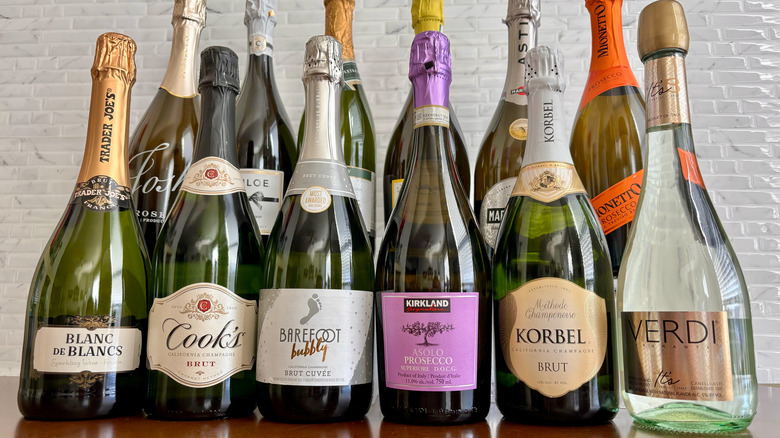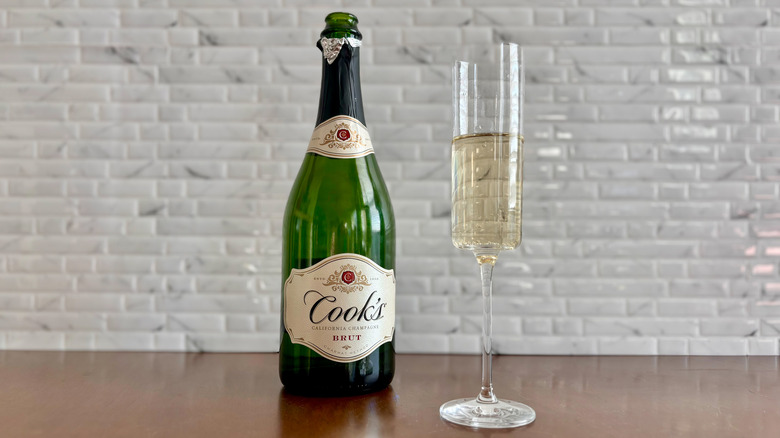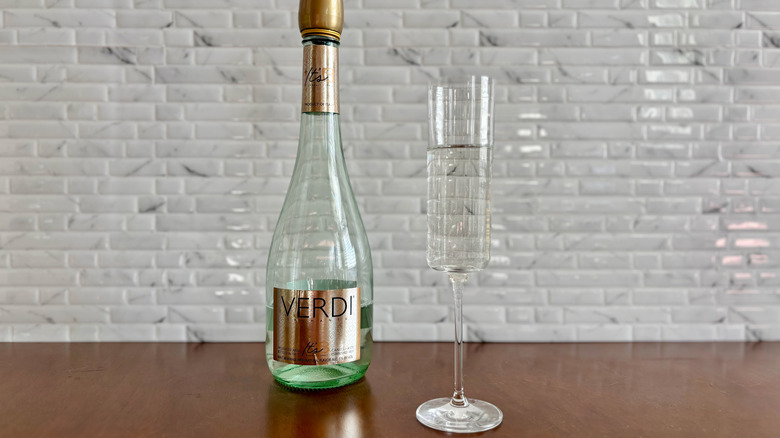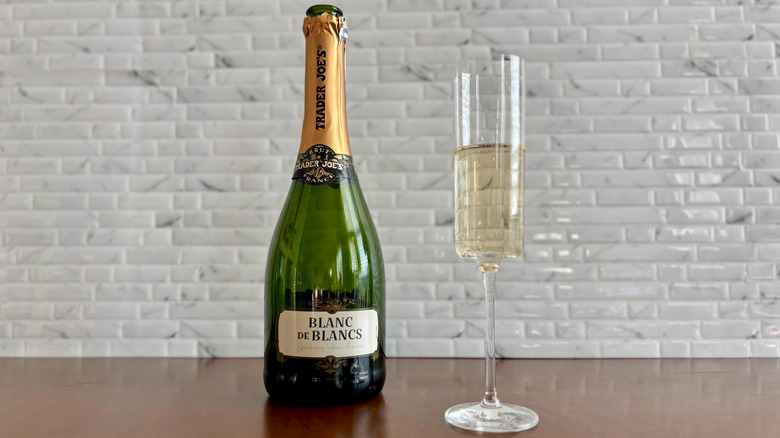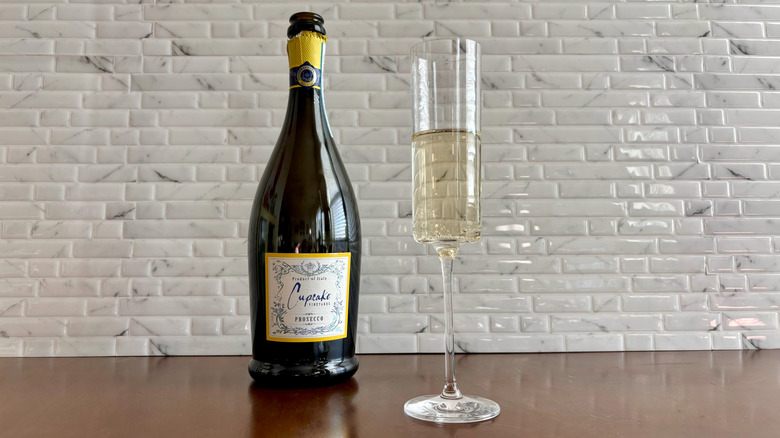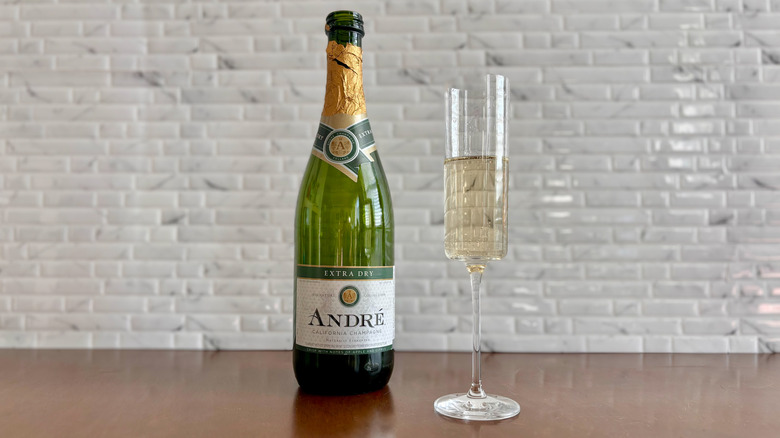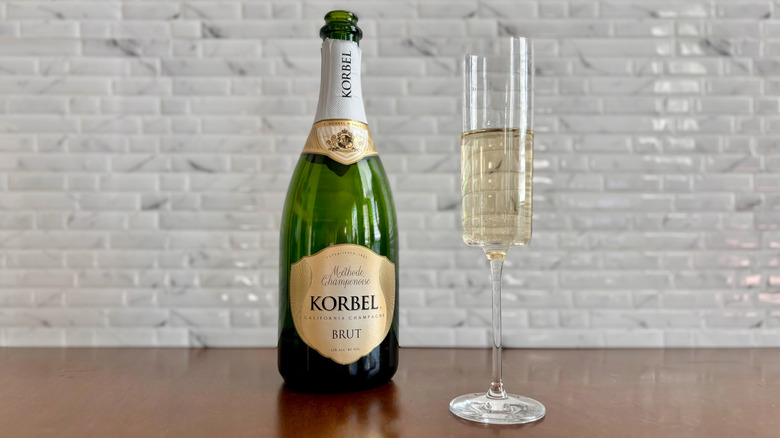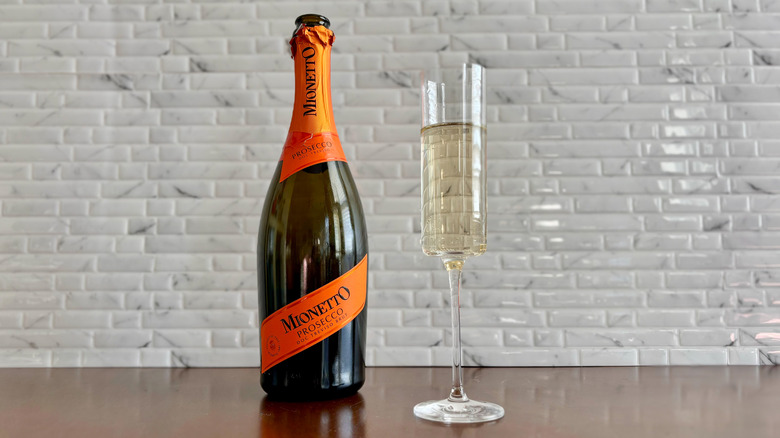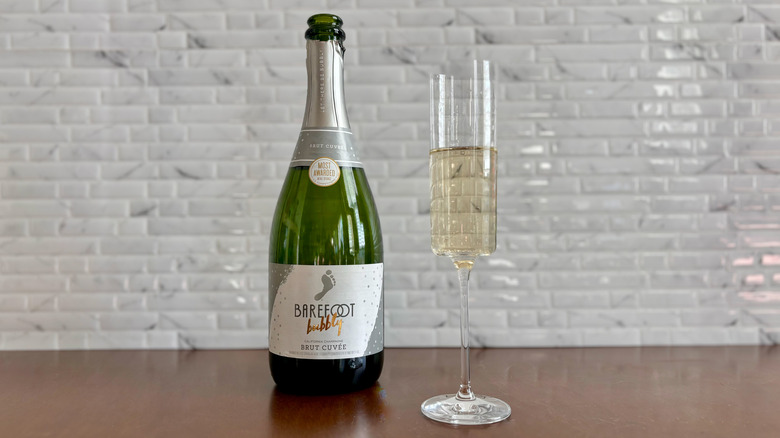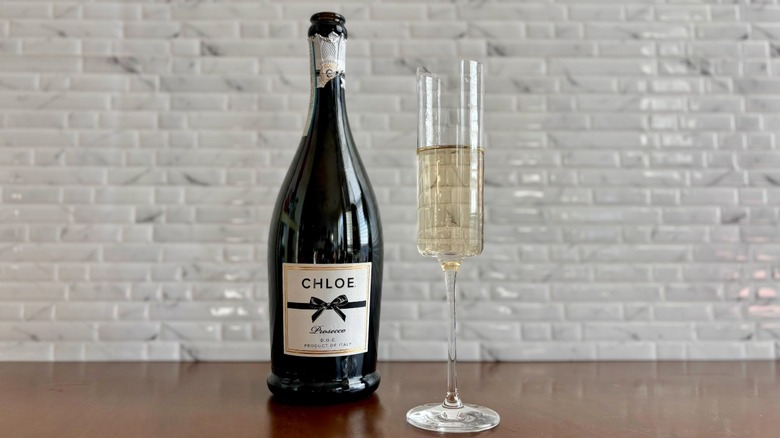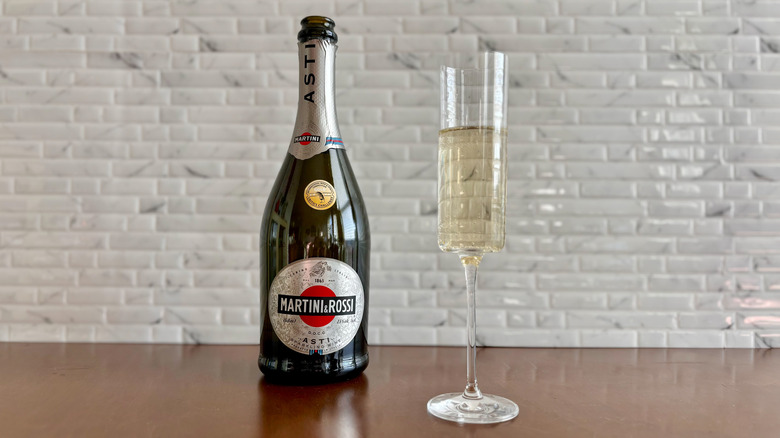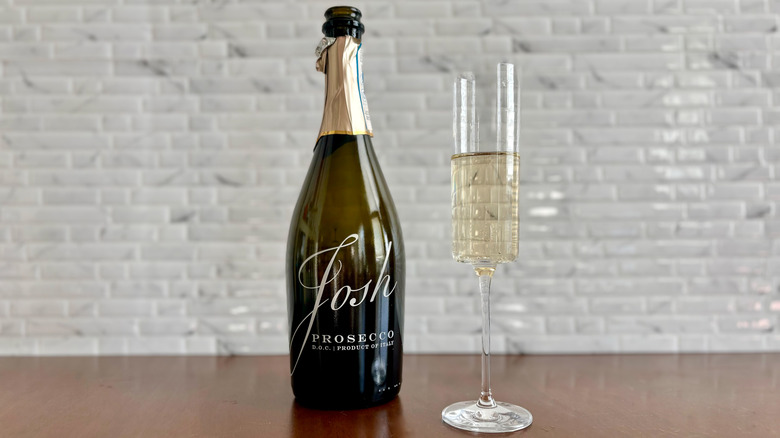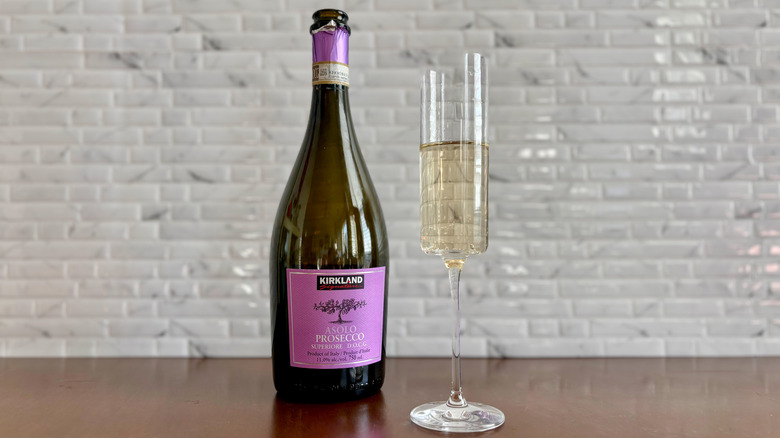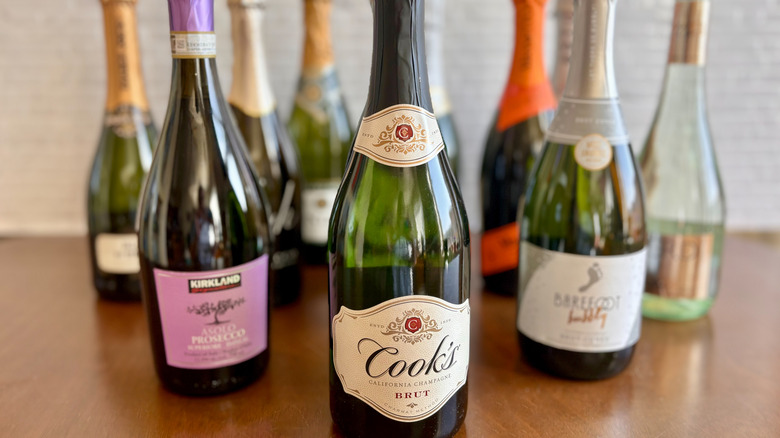12 Cheap 'Champagnes,' Ranked
Whether celebrating a birthday party, graduation, wedding, or anniversary, certain occasions call for some sparkle. Enter Champagne, the go-to fizzy wine for all things festive, offering up a delightfully light and bubbly profile that keeps the good times rolling. But anyone who has ever sought out genuine Champagne knows that it can be expensive, which is why more budget-minded folks tend to opt for sparkling wine instead of actual Champagne.
So, what sets Champagne apart from sparkling wine? It comes down to where the bubbly was made — if it comes from the Champagne region of France, then it's Champagne. If it's made anywhere else in the world, then it technically isn't Champagne, it's sparkling wine ... but we still refer to sparkling wine as Champagne, since it's a recognizable umbrella term for this effervescent libation. As it turns out, there are actually quite a few different types of sparkling wines, and ultimately, many will have similar flavor profiles — and, of course, plenty of bubbles.
In an effort to figure out which cheap "Champagne" is the best of the best, I sampled 12 popular and widely available sparkling wines that are relatively inexpensive. None of the "Champagnes" on this list are actual Champagne — they are all some sort of sparkling wine, geared toward those who want to pop a celebratory bottle without spending too much money doing so. Of the sparkling wines on this list, I discovered a clear-cut, budget-friendly winner that is worthy of enjoying at your next party ... and I also unearthed several options best left on that bottom shelf.
12. Cook's Brut California Champagne
If you've ever taken a stroll down the sparkling wine aisle at your local supermarket or liquor store, it's almost guaranteed that you've seen Cook's somewhere on the shelves (likely closer toward the floor). As a quintessential cheap American sparkling wine brand, Cook's is widely available. Typically, you'll see a few options in the Cook's lineup, including brut, extra dry, or spumante, the latter being a sweet wine.
Unfortunately, Cook's sparkling wine is simply not good, so don't be tempted to reach for it just because it's ubiquitous. There was so much wrong with this bubbly that it's almost impossible to pinpoint all of the flaws. For starters, the Cook's I sampled was brut, which according to the chart on the back of the bottle meant that it's medium-dry. So, imagine my shock when I took a sip and was met with a cloyingly sweet, chemical-tasting mess. If Cook's dry wine tastes that sweet, I'm scared to know how the sweeter versions taste; I've already got a headache just thinking about it.
Sweetness aside, Cook's just tastes as cheap as it is. Which, in some ways, I can't really fault it for; it's not pretending to be a high-end, expensive sparkling wine. It's just Cook's — it's cheap, it's too sweet, it has a weird aftertaste, and it's better off dumped down the drain.
11. Verdi Spumante
I never knew that twist-off Champagne was even a thing, but when you seek out the cheapest possible sparkling wines, you're bound to come across some shocking discoveries. Indeed, Verdi Spumante has a twist-off cap, which pretty much tells you everything you need to know before even opening the bottle. Upon twisting off said cap, I was met with the saddest, most pathetic "pop" that I've ever heard from so-called sparkling wine. Again, this did not bode well for how Verdi was going to taste. Spoiler alert: It wasn't good.
As was predictable from the lack of pop when I twisted off the bottle's cap, this wine had hardly any sparkle to it. While it wasn't completely flat, it almost feels misleading that this wine could be labeled as spumante. The flavor was incredibly lacking, though if there's one good thing I can say about Verdi, it's that its taste was not terribly offensive. Instead, it was just remarkably bland, tasting more like sugar water than anything else — and, as you can see in the picture, it literally looked like water in a glass.
Upon closer inspection of the bottle, I saw that Verdi has 5% alcohol by volume, which kind of made the sugar-water flavor more understandable. Champagnes typically have 12% ABV, so 5% is quite low for a sparkling wine. If you're looking for something super-sweet and low in alcohol, then maybe, just maybe, you'd enjoy Verdi. But realistically, even despite being very cheap, it's really just not worth opting for this when there are better sparkling wines at similar price points out there.
10. Trader Joe's Blanc de Blancs Sparkling Wine
If there's one major disappointment on this list, it's Trader Joe's Blanc de Blancs Sparkling Wine, which I expected so much more from. I'm an avid Trader Joe's shopper, and I've definitely enjoyed my fair share of Two Buck Chuck, so I know that TJ's can provide cheap wine that still tastes pretty decent. Alas, the chain's inexpensive take on sparkling wine missed the mark completely. At its absolute best, this sparkling wine is forgettable, and at its worst, this wine is completely unpalatable.
The first flavor note that I picked up when sipping this wine was a sour one, which wasn't necessarily entirely unwelcome among so many unexpectedly sweet options. That sourness really clung to the palate, however, and it quickly transformed into a chemical aftertaste that was citrusy in the worst way possible. This wine also burned my throat as it went down, which truly goes to show how sour and acidic it was. TJ's has a lot of great products to offer, including those in the alcohol section, but Trader Joe's Blanc de Blancs Sparkling Wine is certainly not one of them.
9. Cupcake Prosecco
Much like Trader Joe's sparkling wine, Cupcake Prosecco was also a bit of a disappointment ... not quite as much of one as the TJ's abomination, but still pretty bad. Cupcake is a fairly ubiquitous brand of wine, available almost wherever vino is sold, and though the brand doesn't just sell sparkling wine, this Prosecco certainly is a popular option in its lineup. Something notable about Cupcake is that you're more likely to find it occupying store space a little more towards a middle shelf than a bottom shelf; it's still very cheap sparkling wine, but it's a step up from other options on this list (ahem, Cook's).
Unfortunately, Cupcake's Prosecco isn't as much of a step up as it perhaps should be. This sparkling wine has a very citrusy flavor note to it, but not in a tasty way — more of a Pine-Sol, soapy kind of way. The wine also had a very pungent aftertaste to it, which is something that could be said for many of the options on this list, but Cupcake's was completely unavoidable. Sure, Cupcake isn't the absolute worst sparkling wine on this list, but it's far from the best, and I certainly don't see myself repurchasing this Prosecco ever again.
8. André Champagne Extra Dry
Much like Cook's, André is something of a celebrity, at least when it comes to the bottom shelf of the sparkling wine section. Indeed, there's a very good chance that you've had André before, as it's widely available and one of the absolute cheapest options on this list. Yet, while André was not particularly tasty by any means, it does begin to bridge a gap on this list between those sparkling wines that are completely unpalatable and those that are beginning to taste somewhat okay.
Despite claiming to be extra dry, this André variety was actually pretty sweet, though I actually didn't find it to be nearly as cloying as Cook's or Verdi. Like Cupcake, this one had a sort of chemical aftertaste that was pretty hard to ignore, but I would say that it wasn't quite so offensive. Ultimately, André is a get-what-you-pay-for kind of wine; it's super-cheap, it's bubbly, it's sweet (even though it perhaps shouldn't be), and if you can manage to choke down a couple glasses of it, then perhaps you'll be able to forget all the negatives.
7. Korbel Brut
Korbel was the very first sparkling wine that I sampled from this list, purely by chance, so you'd think it might have left more of an impression than, say, bottle number seven or eight. Alas, Korbel really didn't leave me with any lingering thoughts, but I suppose that's both a good and bad thing. As for the good part, there was nothing obscenely offensive about Korbel — it didn't taste too sweet, it was expectedly nice and bubbly, and it was perhaps a bit tart more than anything else. As for the bad, it's clearly a pretty unremarkable option in the lineup, not leaving me with a lasting impression despite being the first bubbles to hit my palate.
Something that I can appreciate about Korbel is that it felt like a true brut — unlike so many others on this list that claimed to be brut or extra dry but ended up being sweet, Korbel was indeed nice and dry. Some might argue that it's a bit too dry, with those tart, sour flavors almost translating into bitterness after a few sips. This one did have an aftertaste, though in the grand scheme of lingering sparkling wine flavors, it could've been worse. That sentiment pretty much sums up Korbel as a whole: It could have been better, it could have been worse.
6. Mionetto Prosecco DOC Treviso Brut
Also somewhat forgettable, but a little more well-rounded in flavor, Mionetto Prosecco DOC Treviso Brut marks the spot on this list where all of the Champagnes from here on out are decent, if not good. Despite being a brut Prosecco, Mionetto did boast some sweetness — but unlike so many before it, the sweetness didn't come off as particularly cloying or unwelcome. This sparkling wine also isn't overly sweet, so you don't need to worry about that, but it's got just enough of a sweet note to balance out any particularly sour or bitter ones.
Overall, Mionetto is a good choice for those who want a good middle-ground sparkling wine. I did find there to be some better options out there, but in a pinch, you can't go wrong with this brand. I will say that if you want a true brut Prosecco, then you're best off opting for one of the higher-ranked options on this list; however, if you like that touch of sweetness, then Mionetto is a solid (albeit unremarkable) option.
5. Barefoot Bubbly Brut Cuvée
If there's a single brand on this list that I would argue is more recognizable than any of the others (at least in the world of cheap wine), then it would have to be Barefoot. Known for much more than sparkling wine, Barefoot does indeed have a whole lineup of bubbly, including the brut cuvée that I sampled (and quite enjoyed) for the sake of this article.
Barefoot's relatively high placement on this list comes down to a few key factors. First of all, the wine wasn't half bad — sure, it was a little sweet, it had a little bit of an aftertaste, and there most definitely are better options out there. But the aftertaste was one that I could easily get past, the sweetness wasn't too cloying, and I was actually able to pick up on some more specific flavor notes — like those of Granny Smith apples — than I experienced with other wines on this list.
Another reason that Barefoot is ranking where it does is because it's super-accessible, it's nice and cheap, and it's a recognizable brand that, when in doubt, turns out to be a pretty safe bet. It's quite bubbly, very apple-forward (almost reminiscent of cider at certain sips), and an all-around solid choice.
4. Chloe Prosecco
Something severely lacking in so many sparkling wines on this list is complexity — and, for what it's worth, you can only expect so much complexity from bottom-to-mid-shelf options. However, Chloe Prosecco managed to defy certain odds, packing a notable mix of flavors into the bottle and managing to taste pretty darn good.
Something that I really liked about this Prosecco was how many notes I picked up on as I sipped — a little bit of citrus, slight sweetness but not too much, and just the right mineral-forward edge to round it all out. For being a cheap "Champagne," Chloe delivered with a pretty nuanced flavor profile.
Another perk to this Prosecco is that the bubbles were just right. Obviously, each wine on this list is sparkling, but some of them were certainly more bubbly than others, and Chloe finds a perfect middle ground. It wasn't so bubbly that it was like drinking foam, but it was nowhere near flat. It was just a great sip: sparkling, balanced, and a good option for those who don't want something too sweet.
3. Martini & Rossi Asti
Martini & Rossi produces a type of Asti, which, like Champagne, refers specifically to where the wine is made — in the case of this wine, Italy, and more specifically in the town of Asti. I was a bit hesitant going into this one, because unlike all the other sparkling wines on this list, Martini & Rossi Asti boasts a sweet flavor profile, so I could only imagine that a sickly sweet, cloying flavor profile might be in store.
Much to my surprise (and enjoyment), this Asti was remarkably smooth and balanced. Yes, it is indeed a sweet wine, but the sweetness went down quite easily, and never felt overbearing.
Ultimately, Martini & Rossi Asti breaks into the top three because it proved to me that some sweet wines can actually taste good. Also, there are plenty of people out there who prefer sweet wine, so if you want a little sweetness with your bubbles, this is the one for you. There's more than just pure sweetness at play, too; there were notes of peach and honey present in this wine, which made it all the more enjoyable.
2. Josh Prosecco
Of all the sparkling wines on this list, Josh was the most expensive, coming in at about $16 for the bottle; of course, the price will vary depending on your location. Naturally, I had high expectations for Josh based on price alone — not that $16 is expensive for a bottle of bubbly, but it is when compared to others on this list that cost less than $10. Needless to say, with Josh Prosecco coming in second place, this was a solid sparkling wine through and through, and it's one that's worth the (slight) splurge.
Josh works so well because it strikes a balance that many of the other wines simply couldn't compete with. It was a little bit tart, had the slightest touch of sweetness, and was simply effervescent on the tongue. Drinking this Prosecco felt like a treat, and not one that necessarily blows you away — because this is, after all, a relatively cheap bottle of wine — but one that goes down easy and doesn't leave any unpleasant aftertaste. There's really nothing bad to say about Josh, but there was one other sparkling wine in this lineup that somehow managed to outdo it.
1. Kirkland Signature Prosecco
Anyone with a Costco membership knows that many treasures are waiting to be found in any given warehouse, and one such hidden gem is none other than Kirkland Signature Prosecco. There are many popular wines to buy at Costco, including bottles from well-known wineries, but you might as well skip the name-brand stuff and reach right for Costco's own bubbly. Considering that I paid under $8 for this, you really can't beat Kirkland Signature Prosecco, allowing even those on a budget to celebrate in style (and flavor).
Much like the other successful wines on this list, Costco's Prosecco struck a nuanced balance flavor-wise — not too sweet, not too bitter, not too sour, not too tart, not too acidic. Just a little bit of everything, bottled up and bubbly as can be. As I sipped on this Prosecco, I noticed that it almost didn't taste like alcohol, despite having a pretty standard 11% ABV. It's a little mineral-forward, crisp, and extra dry; I could see myself purchasing another bottle of Kirkland Prosecco just because, with no special occasion or celebration necessary.
Methodology
When selecting which bottles of "Champagne" to feature in this article, I considered well-known brands — like André, Barefoot, and Cook's — along with offerings from popular stores, like Costco and Trader Joe's. There was no way to possibly encompass every single brand of sparkling wine out there, but I feel that these selections offer a wide range and cover a decent amount of ground in terms of variety and price points.
Speaking of price, what I paid for the bottles on this list ranged from about $6.50 for André, being the cheapest, up to about $16 for Josh, which was the most expensive. Now, these prices will vary depending on where you live and which stores you choose, but I tried to keep things truly "cheap" and chose a selection of sparkling wines that are ultimately quite similar in price.
Finally, when tasting each wine, I took time to write down flavor notes, impressions, and general thoughts before moving on to the next. I figured that this was the fairest way to go about it, seeing as this taste test could easily turn into a blur of bubbles — I made sure to give each wine due diligence, and approach it with as open a mind as possible before tasting.
